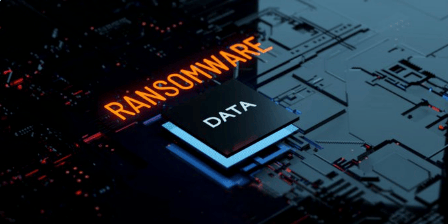
You have a lot going on, so join the thousands of other leaders and let me do the work and provide you with curated cybersecurity content. It would be my honor to do so.

NOTES: If you want to ensure you get this newsletter every week, please add my "from" address to your contact list. If you would like to Unsubscribe scroll to the bottom and select "unsubscribe". Thank you.
In this week's edition:
Cyber Stats
Cyber Warning - 5 Most Common Types of Spear Fishing Attacks
Featured Article - Ransomware in 2023: A Look at the Growing Sophistication and Dangers
Free Cybersecurity Resources - eBooks, tools, apps & services
Trending Story - Data breach statistics 2023’Q1 vs. 2022’Q4
Cybersecurity News Highlights
Cyber Scam of the Week - Watch Out for FedNow Scams
Social Posts of the Week

Cyber Stats
Here are some interesting cybersecurity statistics:
Here are 12 of the most recent cybersecurity statistics since April 2023 and their sources:
The average cost of a data breach is $4.24 million. (Source: IBM Security Cost of a Data Breach Report, 2023)
The most common type of data breach is a phishing attack. (Source: Verizon Data Breach Report, 2023)
The average time it takes to detect a data breach is 206 days. (Source: IBM Security Cost of a Data Breach Report, 2023)
The average time it takes to contain a data breach is 73 days. (Source: IBM Security Cost of a Data Breach Report, 2023)
The average cost of a data breach per lost or stolen record is $150. (Source: IBM Security Cost of a Data Breach Report, 2023)
The most common types of data that are stolen in data breaches are credit card numbers, Social Security numbers, and email addresses. (Source: Verizon Data Breach Report, 2023)
The average person is affected by a data breach every 14 months. (Source: Ponemon Institute, 2023)
The most common way that people are affected by data breaches is through identity theft. (Source: Ponemon Institute, 2023)
The average person spends 17 hours a year dealing with the consequences of a data breach. (Source: Javelin Strategy & Research, 2023)
The most common way that people learn about a data breach is through the news. (Source: Ponemon Institute, 2023)
Only 23% of people take steps to protect themselves after learning about a data breach. (Source: Ponemon Institute, 2023)
Only 39% of people believe that their organizations are prepared to handle a data breach. (Source: Ponemon Institute, 2023)
Early Warning - Five most common types of spear phishing attacks
Spear phishing attacks are a serious threat, and it's important to be aware of them.
The five most common types of spear-fishing attacks are:
Email phishing: This is the most common type of spear phishing attack. It involves sending an email that looks like it's from a legitimate source, such as a bank or a government agency. The email will often contain a link or attachment that, if clicked on, will install malware on the victim's computer.
Whaling: This is a type of spear phishing attack that targets high-profile individuals, such as CEOs or other executives. The goal of whaling is to steal sensitive information, such as financial data or intellectual property.
Vishing: This is a type of spear phishing attack that uses phone calls instead of emails. The attacker will call the victim and pretend to be from a legitimate source, such as a bank or a government agency. The attacker will then try to trick the victim into giving them sensitive information, such as their Social Security number or credit card number.
Smishing: This is a type of spear phishing attack that uses text messages instead of emails. The attacker will send the victim a text message that looks like it's from a legitimate source, such as a bank or a delivery service. The text message will often contain a link or attachment that, if clicked on, will install malware on the victim's phone.
Watering hole attacks: This is a type of spear phishing attack that targets specific websites or online communities. The attacker will infect the website or community with malware, and then wait for the victim to visit the site or join the community. Once the victim visits the site or joins the community, they will be infected with the malware.
Sources: The National Institute of Standards and Technology (NIST), The Cybersecurity and Infrastructure Security Agency (CISA), and The Federal Trade Commission (FTC)
Featured Original Article
Ransomware in 2023: A Look at the Growing Sophistication and Dangers

Image Source and Credit: FreeImages
While rapid advances in technology have resulted in corresponding improvements in cybersecurity measures; sadly, this progress has not deterred cybercriminals from increasing their arsenal of tricks that leverage new more sophisticated capabilities.
As we continue to move through 2023 one particular threat continues to loom large: ransomware.
Ransomware presents a persistent danger for individuals as well as businesses worldwide with its capacity for creating considerable damage compounded by the arrival of newly emerging varieties containing advanced functionalities that make them more formidable than before
In light of the considerable challenges posed by ransomware attacks on global digital infrastructure - in this article, we will explore ransomware’s evolution over time while analyzing its severe impact on society as a whole before outlining strategies that organizations can adopt for protecting themselves against these never-ending security threats.
The Evolution of Ransomware: A Decade of Change
In the past decade, the threat posed by ransomware has evolved exponentially with cyber attackers investing heavily in increasingly advanced techniques aimed at infiltrating vulnerable IT infrastructures and deploying malware capable of rendering entire corporations inoperable. Central to this evolution has been a new focus on both artificial intelligence and social engineering tactics which provide hackers with new more advanced ways of gaining entry into their target networks. Groups such as BlackCat have industrialized these tactics resulting in soaring rates of successful attacks that come complete with increasingly large ransom demands.
In order for organizations not only to survive but thrive in today's digital era it is vital that they invest heavily now into implementing robust security measures and staying one step ahead by constantly monitoring hacker techniques so as not to be impacted by the latest wave of cyber-attacks.
Common Types of Ransomware in 2023
Let's take a look at some of the most common types of ransomware that have emerged in 2023.
Scareware
Scareware is a type of ransomware that is typically distributed through deceptive pop-up ads or emails that appear legitimate but contain malicious code. Once installed on a victim's device, scareware displays fake warnings about viruses and other security issues in order to scare users into paying for unnecessary antivirus software or services.
Locker Malware
Locker malware is another common form of ransomware that works by locking up all files on an infected device until the user pays the ransom demand in order to regain access. This type of attack usually involves sophisticated encryption algorithms, making it difficult to recover data without paying the ransom.
Double Extortion
Double extortion is a more recent trend in ransomware attacks, where attackers not only encrypt the victim's data but also threaten to release or sell the data if the ransom is not paid. This adds an additional layer of pressure on the affected organization to pay up, as the consequences of a data leak can be severe.
Cryptojacking
Cryptojacking is a newer form of ransomware that involves secretly installing malicious software onto a victim's device, using the device's computing resources to mine cryptocurrency for the attacker. This type of attack is often difficult to detect and can run in the background without the user's knowledge.
The Impact of Ransomware Attacks
The devastation wrought by ransomware attacks on individuals and organizations cannot be underestimated. It's a grim reality where being locked out of critical documents or systems leads to heavy financial fallout such as huge ransom payments along with other financial damages, a negative impact on organizational productivity & significant reputation recovery efforts. Sadly, this concern is predicted to get worse with time with several studies predicting that by 2025 there will be an increase both in the complexity and scale of these malicious cyber-attacks posing formidable hurdles to effective countermeasures.
Strategies for Defending Against Ransomware Attacks
To protect against ransomware attacks, organizations must implement a multifaceted approach that includes:
Regular data backups: Ensure that multiple copies of your files are stored in different locations so that if an attack occurs, you can quickly restore your data from a secure backup.
Strong password management: Use complex passwords that include upper and lower-case letters, numbers, and special characters.
Multi-factor Authentication: Enable multi-factor authentication wherever possible and utilize geo-tracking to enable IT admins to track the real-time physical location of roaming users' devices
Employee education: Train your employees to recognize the signs of a ransomware attack and how to respond quickly and effectively.
Endpoint protection: Deploy endpoint detection and response (EDR) solutions that can detect and neutralize ransomware threats.
Regular software updates: Keep your software and firmware up to date to minimize the risk of attackers exploiting known vulnerabilities.
Tested Incident Response: To enable an organization to quickly detect and halt attacks, minimizing damage and potentially preventing future attacks.
Technologies to Mitigate Future Ransomware Threats
Organizations should consider investing in advanced technology solutions to stay ahead of evolving ransomware threats, such as:
Endpoint Detection and Response (EDR): EDR solutions use machine learning and AI to detect and respond to threats in real time, helping to protect your organization from ransomware attacks.
Sandboxing: Sandboxing technology analyzes potential threats in a safe, isolated environment, preventing malware from infecting your network.
Behavior Analysis: By monitoring and analyzing user and system behavior, behavior analysis technology can help identify ransomware attacks before they can cause significant damage.
Zero-Trust Security: Implementing a zero-trust security model based on “Never Trust and Verify” can help ensure that only authorized users and devices can access your network and data.
Deception Technology: Deception technology creates realistic but fake assets within your network, luring attackers away from your actual data and systems.
Be Cautious and Prepared
The evolving sophistication and frequency of malware attacks like ransomware reinforce the need for organizations to adopt proactive cybersecurity measures continually.
One effective way organizations can ensure confidentiality and privacy for personal data protection is by utilizing encryption technology. Encryption ensures any stolen data cannot be accessed or decrypted by cyber attackers making it less valuable and harder for cybercriminals.
They should also consider leveraging a combination of security technologies mentioned to protect their networks from ransomware attacks. Additionally, organizations should stay up to date on the latest developments in cybersecurity, ensuring that their systems are protected from the latest threats. By remaining vigilant and proactive in their efforts to protect their networks from ransomware attacks, organizations can better safeguard themselves from these increasingly dangerous threats.
Additionally, organizations willing to assume some level of risk may self-insure or invest in proper cyber insurance policies capable of providing gap coverage & financial protection against losses stemming from any successful ransomware attack sustained.
Adopting preventive measures such as this while staying updated on evolving trends & implementing tight security countermeasures goes a long way in protecting businesses from the growing dangers associated with ransomware.
Free Resources
CSO Online: "The CSO guide to top security conferences"
Web Security Academy - Free, online web security training
At Bay - Free Cyber Risk Calculator
Trending Story
Other Bytes
Cyber Scam of the Week
Watch Out for FedNow Scams
FedNow is a new instant payment service created by the Federal Reserve. This service allows banks from all over the US to provide instant funds to any of their customers. Any consumer could use FedNow to instantly send and receive payments.
In the coming months, we expect to see an influx of cyber criminals trying to take advantage of FedNow’s popularity in their phishing scams. For example, cybercriminals may send you an email claiming that you were sent a payment through FedNow. The email may state that you need to click a link and enter your bank account information in order to claim the payment. Unfortunately, if you enter your banking information, you won’t receive a payment in your bank account. Instead, cybercriminals could steal your money for their own malicious purposes.
Follow the tips below to stay safe from similar scams:
Remember that this type of attack isn’t exclusive to FedNow. Cybercriminals could use this technique to impersonate any instant payment service.
Think before you click. Cyberattacks are designed to catch you off guard and trigger you to click impulsively.
Be cautious of unexpected payout opportunities. Remember, if something seems too good to be true, it probably is!




